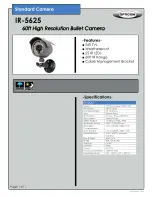
6. Troubleshooting
- 3 -
2. Primary response
The work done at the hospital or clinic constitutes the primary response. Only service engineers or
medical engineers (ME) are allowed to do this work. When service engineers are to pay service
calls to hospitals or clinics, it is recommended that they take with them the tools listed below and
an detector which the sales company owns and which can be loaned out. What must be done
without fail if the trouble has been resolved by replacing the unit is to replace the new unit with
the original unit and verify that the trouble recurs.
•
Notebook computer purchased on the market (incorporating the IEEE 802.11n specification):
Used to check the wireless environment when trouble with wireless communication has
occurred
•
Large storage media (at least 100 GB recommended): To save the collected data
•
Detector
•
AC/DC box
•
Detector cable
•
Infrared data communication unit
•
Wireless LAN access point
Described below are the symptoms of the trouble which may conceivably occur at hospitals and
clinics and the suspected causes of the trouble.
[When infrared communication (detector recognition) is not possible]
Symptom (1):
The detector was recognized using infrared communication, but the three LEDs on the detector
failed to light (for about 1 second).
Suspected causes:
•
Defective connection between the image capture computer and infrared data communication
unit
•
Problem in work environment (the unit must not be located close to a monitor or installed in an
environment where signals are reflected)
•
Failure of LNK Controller, service tool, to start up
•
Incorrect setting of the AP/LNK configuration tool (COM port setting of connect tab), a service
tool
•
Trouble with infrared data communication unit
•
Trouble with FPC-UIF board (board inside detector)
•
Trouble with PCA-11nWM board (board inside detector)
Conduct checks based on the suspected causes listed above or replace the unit.
Symptom (2):
•
The three LEDs of the detector lighted up (for about 1 second) with infrared communication and
the detector was recognized successfully, but the blue-green LED failed to light.
Suspected causes:
•
The power of the access point has not been turned on.
•
Incorrect setting of the access point using the AP/LNK configuration tool
Conduct checks based on the suspected causes listed above.
Summary of Contents for CXDI-80C
Page 6: ...Note These measurements are only guidelines ...
Page 10: ...1 1 O Ov ve er rv vi ie ew w 2 2 System diagram ...
Page 48: ...2 Installation procedures 15 4 Handle unit option Corner pads Outer box Inner box ...
Page 133: ...Rev 01 CONTENTS Detector unit 1 X ray interface box unit 2 Wiring unit 4 Handle unit 6 ...















































